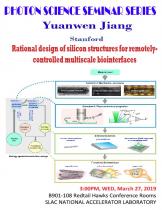Speaker: Dr. Yuanwen Jiang
Program Description:
Silicon (Si)-based materials have a wide range of utilities in biophysical and biomedical research. For example, dopant modulated and kinked silicon (Si) nanowires allow for intracellular electrical recording from single cells with a field effect transistor configuration. Bendable integrated circuits, based on Si nanoscale membranes and their seamless interfaces with thermal oxide, open the way for long-lived bioelectronic implants. Although the electrically registered device components have yielded impressive results, remotely-controlled and freestanding systems are rarely employed in biointerface studies. This is largely due to our limited understanding of the physicochemical processes at the freestanding material surfaces under physiological conditions. In particular, a quantitative understanding of the light-induced electrical, electrochemical, and thermal pathways across multiple length scales, if achieved, would likely promote future biointerface innovations.
In this talk, I will first introduce an exploratory study of using mesostructured Si as the first biodegradable platform to achieve light-controlled neuromodulation. Based on the initial demonstration, I will then introduce a biology-guided rational design principle by first considering material structures and mechanics and then the efficient signal transductions at the Si surfaces in saline. In particular, I will discuss a general method that can quantify and differentiate the light-generated capacitive, Faradaic and thermal outputs of virtually any materials in saline. Next, I will demonstrate the utility of three selected classes of Si materials by showing light-controlled non-genetic modulations of multiscale biological activities, including intracellular calcium dynamics, cytoskeleton-based transport and structures, cellular excitability, neurotransmitter release from brain slices, and brain activities in vivo. I will end my talk by discussing some fundamental aspects of Si material synthesis that have helped to elucidate the underlying physicochemical processes that shape the Si structures and properties.





